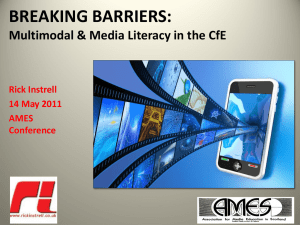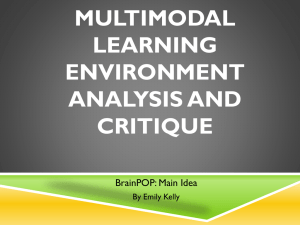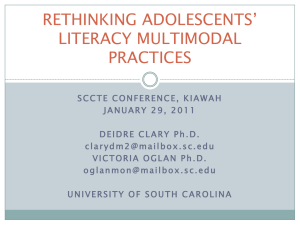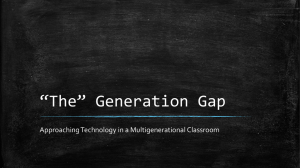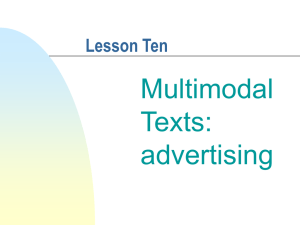What is multimodal transcription?
advertisement
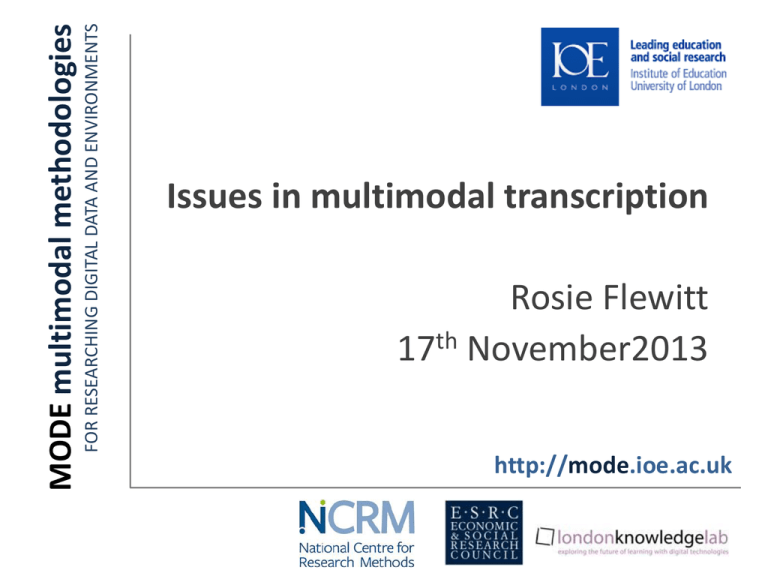
FOR RESEARCHING DIGITAL DATA AND ENVIRONMENTS MODE multimodal methodologies Issues in multimodal transcription Rosie Flewitt 17th November2013 http://mode.ioe.ac.uk • • • • • • What is multimodality? What is a mode? What are multimodal data? How do we collect multimodal data? What is multimodal transcription? How is this relevant to my research? MODE multimodal methodologies FOR RESEARCHING DIGITAL DATA AND ENVIRONMENTS What is multimodality? ‘Multimodality is an inter-disciplinary approach that understands communication and representation to be more than about language. It has been developed over the past decade to systematically address much-debated questions about changes in society, for instance in relation to new media and technologies. Multimodal approaches have provided concepts, methods and a framework for the collection and analysis of visual, aural, embodied, and spatial aspects of interaction and environments, and the relationships between these.’ MODE (2012). Glossary of multimodal terms. http://www.multimodalglossary.wordpress.com. Retrieved 23.05.13 MODE multimodal methodologies FOR RESEARCHING DIGITAL DATA AND ENVIRONMENTS What is multimodality? Underlying assumptions 1. 2. 3. …that communication and representation always draw on multiple modes, which all contribute to meaning. This requires attention to and analysis of the full repertoire of meaning-making resources that people use in different contexts. …that meaning making resources are shaped over time to articulate the socially-situated meanings of different communities. The more ‘modes’ are used in a community, the more fully articulated and fine tuned their use becomes, and there is a shared cultural understanding about how sets of resources realise meaning. …people make active choices about which modes to use, so communicational acts are shaped by social norms and conventions AND by individuals’ motivations in specific social contexts. MODE multimodal methodologies FOR RESEARCHING DIGITAL DATA AND ENVIRONMENTS What is a mode? • a set of socially and culturally shaped resources for making meaning (e.g. spoken language, written language, still or moving image, sounds, gesture, gaze and posture in embodied interaction) • created through social processes which evolve over time and are particular to specific communities, where community members share understanding of their meaning. MODE multimodal methodologies FOR RESEARCHING DIGITAL DATA AND ENVIRONMENTS Image removed of child showing how bubble machine works Z1/7 (Videocode 36:50 –37:05) (In garden, Mum goes inside to fetch a “bubble machine”) R: what bubble machine? Zara: (dances, raises arms in air) just a (right arm down, left arm up) bubble machine (left arm drops towards right arm, fingers of right hand make a circle/hole) you put in #dere (left arm drops to put index finger of left hand into hole made by right hand) and bubbles come out (raises left arm high and waves it high in the air) and you push a button (mimics pressing button with left hand) MODE multimodal methodologies FOR RESEARCHING DIGITAL DATA AND ENVIRONMENTS What is a mode? Theoretical roots Halliday Language as Social Semiotic (1978): language as socially situated and texts as complex signs A set of resources ‘counts’ as a mode if three Hallidayan ‘metafunctions’ are present: • ‘ideational’ (subject matter) • ‘interpersonal’ (constructing social relations) • ‘textual’ (creating coherence) The debate continues… MODE multimodal methodologies FOR RESEARCHING DIGITAL DATA AND ENVIRONMENTS • • • ideational: what is being represented? intertextual: how is the relationship between author and reader constructed? textual: how are modes combined into a text? What are multimodal data? Multimodal research has changed the landscape for what are accepted as analysable data: In contrast to words, nonverbal signs have often been excluded from study on the grounds that they are problematic for data collection and analysis, ancillary to learning through spoken or written modes and are idiosyncratic or arbitrary, characterized by personal and cultural variations with limited functional potential that render them unsuitable for systematic forms of analysis (Flewitt, 2006: 27) MODE multimodal methodologies FOR RESEARCHING DIGITAL DATA AND ENVIRONMENTS What are multimodal data? • ‘new’ media, and radical ways digital devices have changed contemporary communication • new kinds of research texts • reappraising familiar research texts, e.g. in F2F interaction, and print technologies • reappraising theories of communication and meaning making MODE multimodal methodologies FOR RESEARCHING DIGITAL DATA AND ENVIRONMENTS Collecting multimodal data: practicalities • • • • • • what to record who to record how to record when to record how to gain access; maintaining ethical standards what you do with the information you gather MODE multimodal methodologies FOR RESEARCHING DIGITAL DATA AND ENVIRONMENTS Collecting multimodal data: practicalities • new tools for data collection: affordable and discreet video and audio recorders; cameras; comparative ease for data storage and access • new sites for data collection: ‘real’ and ‘virtual’ life • visual data as one source of information: interviews, field notes, documentation etc give insights beyond narrow focal range of a camera MODE multimodal methodologies FOR RESEARCHING DIGITAL DATA AND ENVIRONMENTS Image removed of children acting out a story Researching with visual data: Ethical issues • data collection: excluding non-participants • representation: anonymizing participants on record; ethical considerations shaping transcription possibilities • selection and interpretation of data record: the veracity of images? MODE multimodal methodologies FOR RESEARCHING DIGITAL DATA AND ENVIRONMENTS Multimodality and transcription convention • Technological developments, but print still prevalent for publication • Transcription conventions: linguistics, sociolinguistics, pragmatics, linguistic anthropology, conversation analysis, and discourse analysis • Established and fairly stable transcription systems: – Gail Jefferson’s (1984) transcription conventions in conversation analysis – McWhinney’s (2000) transcription system widely used in applied linguistics – New forms of representation to the genre, such as line drawings (e.g. Goodwin, 2007; Plowman and Stephen, 2008), and stills from video footage (Heath, Hindmarsh, & Luff, 2010); video stills overlaid with other graphic features such as arrows (Norris, 2004) and musical notation (Erickson, 2004) Mason, B. & Dicks, B. (2001) Going Beyond the Code: The Production of Hypermedia Ethnography Social Science Computer Review 19: 445-457 MODE multimodal methodologies FOR RESEARCHING DIGITAL DATA AND ENVIRONMENTS What is multimodal transcription? • transcription as theory: the mode of data presentation reflects theory-driven research aims and inevitably directs research findings (Ochs, 1979) • multimodal transcription as a selective and interpretive process of making meaning of (often) visual data and representing those meanings on the page (or page-like) screen • how can the different modes of social interaction (e.g. speech, gaze, gesture and body position) be re-presented on the page (or page-like) as writing or as image? MODE multimodal methodologies FOR RESEARCHING DIGITAL DATA AND ENVIRONMENTS ‘Even the most richly detailed vignette is a reduced account, clearer than life. Some features are selected in from the tremendous complexity of the original event […] and other features are selected out of the narrative report. Thus the vignette does not represent the original event itself, for this is impossible. The vignette is an abstraction; an analytic caricature (of a friendly sort) in which some details are sketched in and others left out; some features are sharpened and heightened in their portrayal […] and other features are softened or left to merge with the background’ (Erickson, 1986:150). MODE multimodal methodologies FOR RESEARCHING DIGITAL DATA AND ENVIRONMENTS What is multimodal transcription? • transcript is always a distillation of original video footage, and therefore a reduction. Is more necessarily better? • what is and what is not re-presented? • which modes of communication and which participants are included and excluded? • what is foregrounded in the transcript and why? • which participants, features and modes are made salient and which ones are placed in the background? • balance between accurate notation and clear, legible description for the reader MODE multimodal methodologies FOR RESEARCHING DIGITAL DATA AND ENVIRONMENTS What is multimodal transcription? • graphic re-presentation is not a ‘replica’ of reality, nor does it ‘mirror’reality and it is always more than ‘description’ • the ‘meaning’ is dependent on the researcher and on the reader’- it is a deliberately reshaped representation • by re-configuring/ transducing across modes, the researcher gives meaning to the world, drawing attention to some elements and backgrounding others • rhetorically, there is a thesis to be developed and an audience to be convinced. This is not distortion, but the process of making ‘information’ into ‘data’ MODE multimodal methodologies FOR RESEARCHING DIGITAL DATA AND ENVIRONMENTS Transcription as transduction • shifts across modes in a process of ‘transduction’ (Kress, 1997) • when meanings ‘travel across modes’ there are ‘affective, cognitive and semiotic consequences’ (Newfield, 1999) • processes of ‘transmodal redesign’ (Mavers, 2011) MODE multimodal methodologies FOR RESEARCHING DIGITAL DATA AND ENVIRONMENTS Image removed of child reading with father Ed: Poppy ran into a bridge Dad: is that into (points to word) what does that say? Ed: (points to word) onto Dad: onto? Ed: onto a bridge Dad: brilliant (.) excellent Ed: (gazes at and then points to pic.) the (?) is on the bridge so it’s into Dad: although it’s running into it, the word there (points to word) actually says onto (points) look on Images removed of child reading Steps in transcription process Define focus and purpose > define questions, framing and rhetorical context > select episode Design transcript > create template (tabular; horizontal; visual; time line?) > transcription conventions and improvisation > complete template Refine transcript > annotate transcript > amend transcript > recount transcript (describe what happens; key features) Draw conclusions > address RQs; connect with previous research and theory MODE multimodal methodologies FOR RESEARCHING DIGITAL DATA AND ENVIRONMENTS Multimodal transcription and reflexivity Researcher’s personal interest and theory drive all stages of the research process, and this has implications for methodological and analytical reflexivity: • • • • • • What are my values? Have they changed over the research process? What analytical point am I making? Why do I think this is important? How well does the data support that point? How well have I represented the data? MODE multimodal methodologies FOR RESEARCHING DIGITAL DATA AND ENVIRONMENTS Baldry, A. and Thibault, P.J. (2006) Multimodal Transcription and Text Analysis: A Multimodal Toolkit and Coursebook with Associated On-line Course. Sheffield: Equinox. Bezemer, J. (forthcoming) How to transcribe multimodal interaction? In C.D. Maier and S. Norris (eds). Texts, Images and Interaction: A Reader in Multimodality. Berlin: Mouton de Gruyter. Bezemer, J. and Mavers, D. (2011) ‘Multimodal transcription as academic practice: a social semiotic perspective’, International Journal of Social Research Methodology, 14(3): 191-206. Davidson, C.R. (2009) ‘Transcription: imperatives for qualitative research’, International Journal of Qualitative Methods, 8(2): 1-52. Flewitt, R. S. (2006) ‘Using video to investigate pre-school classroom interaction: education research assumptions and methodological practices’, Visual Communication, 5(1): 25-50. Flewitt, R. S., Hampel, R., Hauck, M. and Lancaster, L. (2009) ‘What are multimodal data and transcription?’ In C. Jewitt (ed) The Routledge Handbook of Multimodal Analysis (pp.40-53). London: Routledge. (NB updated 2nd Edition due 2014) Goodwin, C. (2007) Participation, stance and affect in the organisation of activities, Discourse & Society 18(1): 53-73. Halliday, M.A.K. (1978) Language as social semiotic London: Edward Arnold. Heath, C., Hindmarsh, J. and Luff, P. (2010) Video in Qualitative Research: Analysing Social Interaction in Everyday Life. Los Angeles: Sage. Kress, G. (1997) Before Writing: rethinking the paths to literacy London: Routledge. Mavers, D. (2011) Children’s Drawing and Writing: The Remarkable in the Unremarkable New York: Routledge Norris, S. (2002) ‘The implication of visual research for discourse analysis: transcription beyond language’, Visual Communication, 1(1): 97-121. Norris, S. (2004) Analyzing Multimodal Interaction. London: RoutledgeFalmer. Ochs, E. (1979) ‘Transcription as Theory’, in E. Ochs and B. Schieffelin (eds) Developmental Pragmatics, pp. 43–72. New York: Academic Press. Plowman, L. and Stephen, C. (2008)'The big picture? Video and the representation of interaction', British Educational Research Journal, 34 (4): 541 — 565. mode@ioe.ac.uk

